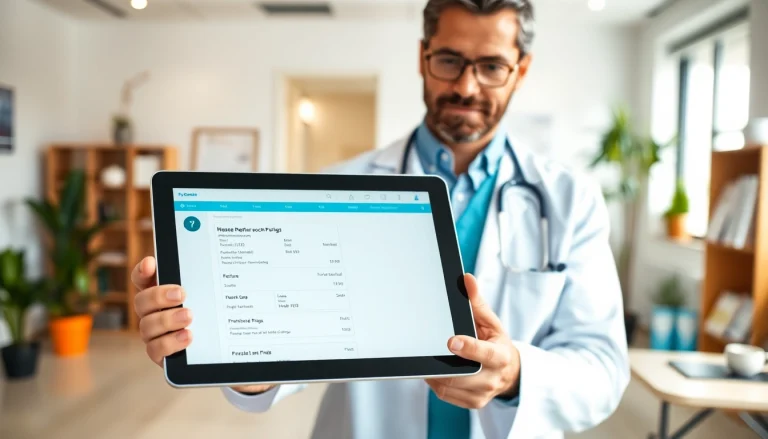Understanding Secure ePrescribing Solutions
Definition and Importance
Secure ePrescribing solutions serve as a transformative element in modern healthcare, enabling healthcare providers to electronically generate and transmit prescriptions to pharmacies. By shifting from traditional paper-based systems to digital channels, ePrescribing enhances efficiency, reduces errors, and improves overall patient care. The integration of security measures ensures that sensitive patient information remains confidential and minimizes risks associated with prescription fraud and abuse. Implementing secure eprescribing solutions thus plays a crucial role in fostering trust and reliability within the healthcare continuum.
Key Features of Secure ePrescribing Solutions
- Electronic Transmission: Secure ePrescribing solutions allow providers to send prescriptions directly to pharmacies through a secure network, ensuring swift processing and reducing wait times for patients.
- Security Protocols: These solutions incorporate advanced security features such as encryption, authentication, and audit trails to protect sensitive patient data and comply with regulations.
- Integration with EHRs: Many ePrescribing platforms seamlessly integrate with Electronic Health Records (EHR) systems, allowing for a holistic view of patient care. This integration aids in monitoring patient medications, history, and allergies.
- Real-Time Access: Healthcare providers can access real-time data regarding medication availability at local pharmacies, which helps in making informed prescribing decisions.
- Support for Controlled Substances: Advanced solutions support ePrescribing for controlled substances, implementing additional security measures to comply with regulatory requirements.
Benefits for Healthcare Providers
Embracing secure ePrescribing solutions brings numerous benefits for healthcare providers, including:
- Efficiency Gains: By automating prescription processes, providers save time spent on paperwork and can focus more on patient care.
- Improved Patient Outcomes: Enhanced accuracy in prescriptions leads to better patient adherence and outcomes, as the risk of manual errors is significantly reduced.
- Regulatory Compliance: ePrescribing solutions help providers meet state and federal regulations regarding prescription security, facilitating compliance with laws like the Drug Enforcement Administration (DEA) regulations for controlled substances.
- Cost Reduction: Reduction in prescription errors, decreased phone calls, and lower administrative burdens lead to overall cost savings for practices.
How Secure ePrescribing Solutions Improve Patient Safety
Reducing Medication Errors
Medication errors pose a significant risk in healthcare, leading to adverse drug events and, in some cases, serious harm to patients. Secure ePrescribing solutions minimize these risks by automating the prescribing process. Electronic prescriptions eliminate the legibility issues that sometimes accompany handwritten prescriptions, thus reducing the likelihood of administration errors. Additionally, built-in safeguards such as alerts for drug interactions and allergy warnings further bolster patient safety.
Enhancing Communication Between Providers and Pharmacists
Direct electronic communication between providers and pharmacists enhances collaboration within the care team. Secure ePrescribing solutions facilitate the sharing of vital patient information, such as medication allergies and health conditions, allowing pharmacists to make informed decisions during medication dispensing. Efficient communication reduces the chances of miscommunication that traditional methods often harbor.
Compliance with Regulations
Healthcare providers are obligated to comply with various regulations designed to protect patient information and ensure safe prescribing practices. Secure ePrescribing solutions are designed with compliance in mind, offering features like two-factor authentication and detailed auditing capabilities that meet stringent regulatory requirements. By adhering to these regulations, providers not only safeguard their patients but also protect their practices from potential liabilities associated with non-compliance.
Implementation Strategies for Secure ePrescribing Solutions
Assessment of Current Practices
Before implementing a secure ePrescribing solution, it is crucial for healthcare providers to conduct a thorough assessment of their current prescribing practices. This includes evaluating existing workflows, identifying pain points, and determining areas where technology can provide enhancements. By understanding current practices, providers can better tailor their ePrescribing implementation to meet specific needs.
Choosing the Right Software
With numerous ePrescribing software vendors available, selecting the right solution is vital. Factors to consider include user interface design, integration capabilities with existing EHR systems, the range of features offered, customer support availability, and compliance with necessary regulations. A robust selection process includes soliciting feedback from all stakeholders including clinicians, pharmacists, and administrative staff.
Training Staff Effectively
Successful adoption of secure ePrescribing solutions largely hinges on effective training. Staff should receive comprehensive training on the selected software’s functionalities, focusing on features that enhance patient safety and operational efficiency. Continuous support and refresher courses can ensure that staff remains proficient and able to take full advantage of the system’s capabilities.
Challenges in Adopting Secure ePrescribing Solutions
Addressing Security Concerns
While secure ePrescribing solutions offer robust security measures, concerns regarding data breaches and cyber threats persist. It is essential for healthcare providers to establish strong security protocols such as regular software updates, data encryption, and comprehensive employee training on data protection practices. Creating a culture of security awareness will significantly reduce the risk of potential breaches.
Integration with Existing Systems
Integrating ePrescribing solutions with existing EHRs can pose technical challenges. Issues related to interoperability often arise when different systems are not designed to communicate effectively. To overcome these challenges, healthcare providers should work closely with IT professionals to ensure seamless integration is achieved, allowing for a smooth flow of information across platforms.
Ensuring User Acceptance
User acceptance is a critical factor in the successful implementation of secure ePrescribing solutions. Resistance from staff can stem from fears of change, unfamiliarity with new technologies, or concerns over impacts on workflow. Engaging users early in the implementation process, collecting feedback, and demonstrating how the new system simplifies their tasks can help alleviate concerns and foster acceptance.
Future Trends in Secure ePrescribing Solutions
Advancements in Technology and Features
The future of secure ePrescribing solutions is bright, with ongoing advancements in technology paving the way for innovative features. Emerging trends include the integration of artificial intelligence (AI) to predict medication needs based on patient history, enhanced analytics capabilities for better decision-making, and even telemedicine integration that allows for instant prescriptions following virtual consultations.
Impact of Telemedicine
The rise of telemedicine has significantly influenced ePrescribing practices. As virtual healthcare becomes more prevalent, secure ePrescribing solutions need to adapt by offering functionalities that support remote consultations. This duality enhances patient access to medications while ensuring that prescribing remains secure and compliant with regulations.
Patient-Centered Innovations
An increasing emphasis on patient-centered care is shaping the landscape of secure ePrescribing solutions. Tools that engage patients, such as mobile applications allowing direct communication with providers or features that provide medication reminders, are becoming essential. By fostering greater patient involvement in their medication management, healthcare providers can enhance adherence and improve health outcomes.






